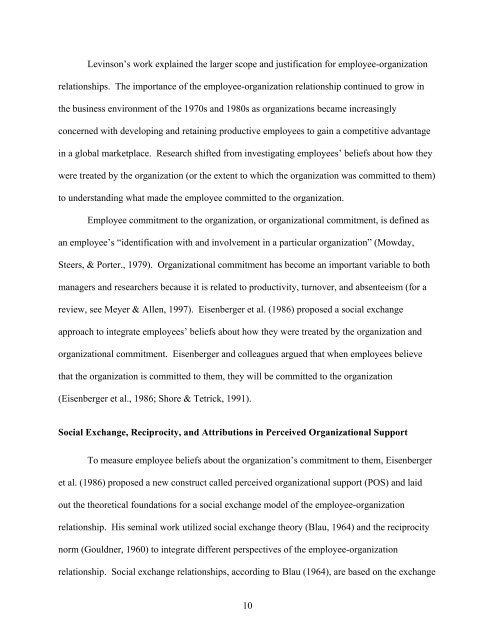a social influence analysis of perceived organizational support
a social influence analysis of perceived organizational support
a social influence analysis of perceived organizational support
Create successful ePaper yourself
Turn your PDF publications into a flip-book with our unique Google optimized e-Paper software.
Levinson’s work explained the larger scope and justification for employee-organization<br />
relationships. The importance <strong>of</strong> the employee-organization relationship continued to grow in<br />
the business environment <strong>of</strong> the 1970s and 1980s as organizations became increasingly<br />
concerned with developing and retaining productive employees to gain a competitive advantage<br />
in a global marketplace. Research shifted from investigating employees’ beliefs about how they<br />
were treated by the organization (or the extent to which the organization was committed to them)<br />
to understanding what made the employee committed to the organization.<br />
Employee commitment to the organization, or <strong>organizational</strong> commitment, is defined as<br />
an employee’s “identification with and involvement in a particular organization” (Mowday,<br />
Steers, & Porter., 1979). Organizational commitment has become an important variable to both<br />
managers and researchers because it is related to productivity, turnover, and absenteeism (for a<br />
review, see Meyer & Allen, 1997). Eisenberger et al. (1986) proposed a <strong>social</strong> exchange<br />
approach to integrate employees’ beliefs about how they were treated by the organization and<br />
<strong>organizational</strong> commitment. Eisenberger and colleagues argued that when employees believe<br />
that the organization is committed to them, they will be committed to the organization<br />
(Eisenberger et al., 1986; Shore & Tetrick, 1991).<br />
Social Exchange, Reciprocity, and Attributions in Perceived Organizational Support<br />
To measure employee beliefs about the organization’s commitment to them, Eisenberger<br />
et al. (1986) proposed a new construct called <strong>perceived</strong> <strong>organizational</strong> <strong>support</strong> (POS) and laid<br />
out the theoretical foundations for a <strong>social</strong> exchange model <strong>of</strong> the employee-organization<br />
relationship. His seminal work utilized <strong>social</strong> exchange theory (Blau, 1964) and the reciprocity<br />
norm (Gouldner, 1960) to integrate different perspectives <strong>of</strong> the employee-organization<br />
relationship. Social exchange relationships, according to Blau (1964), are based on the exchange<br />
10
















